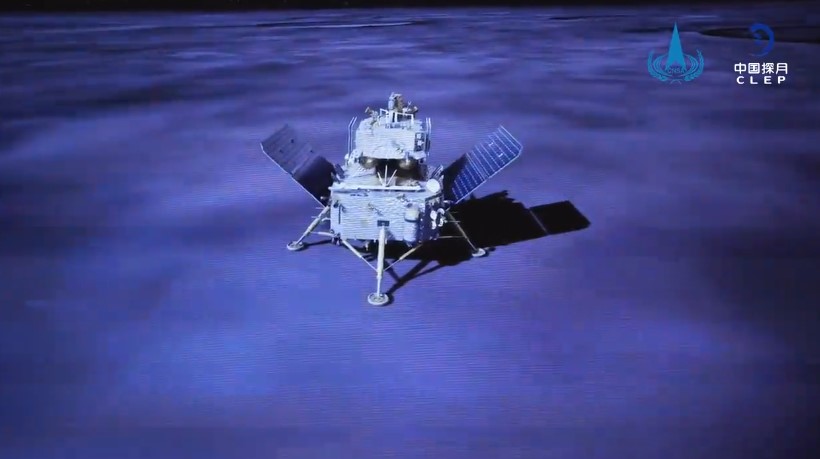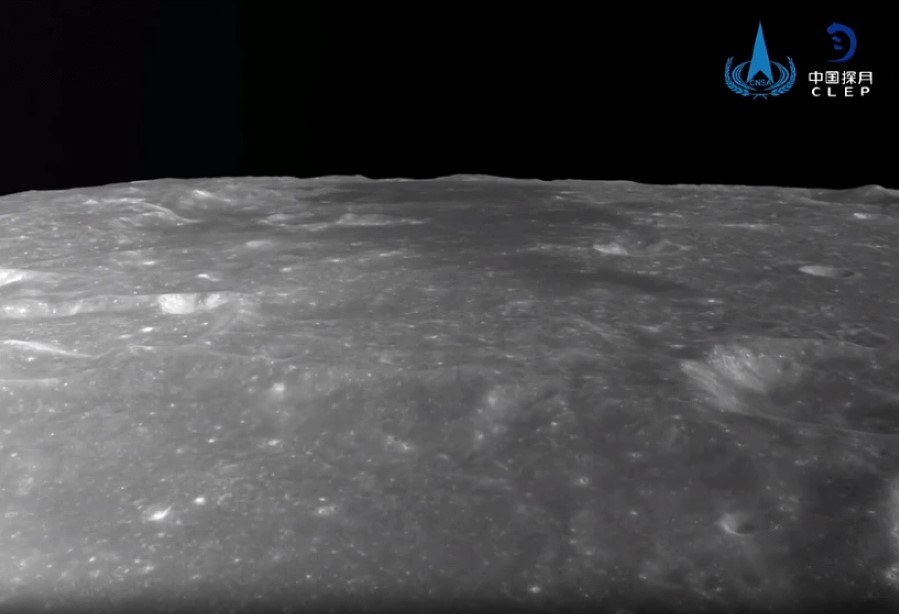China's Chang'e-6 lunar probe takes off from moon with first samples from lunar far side
The ascender of China's Chang'e-6 probe lifted off from lunar surface on June 4, carrying samples collected from the moon's far side, an unprecedented feat in human lunar exploration history. Now it has entered a preset orbit around the moon.
The probe previously landed at the designated landing area in the South Pole-Aitken (SPA) Basin on the far side of the moon at 6:23 a.m., on June 2.
The lander-ascender combination of the Chang'e-6 probe touched down after reducing its relative speed to zero in 15 minutes, under the precise control of the Beijing Aerospace Control Center.

China's Chang'e-6 landed on the far side of the moon on June 2. The image is a simulation showing the solar panel wings of the lander-ascender combination after landing. (Photo from China National Space Administration)
Chang'e-6 consists of an orbiter, a returner, a lander and an ascender. Since its launch on May 3 this year, it has been staying in orbit for about 30 days.
Before its landing, the lander-ascender combination separated from the orbiter-returner combination that kept flying around the moon.
Apart from making a soft landing on the far side of the moon, Chang'e-6 would also collect lunar soil beyond the moon's visible face, said Ge Ping, spokesperson for the Chang'e-6 mission.
According to him, the mission involves many engineering innovations, high risks and great difficulty, and manifests the wisdom of scientists.
Landing on the far side of the moon requires choosing the right location first. Compared to the near side of the moon where Chang'e-5 landed, the far side features a more rugged topography. The pre-selected landing area, the SPA Basin, is generally lower in elevation and has a higher density of impact craters, which posed greater challenges for site selection as the terrain's shadows and obstructions are unfavorable for lighting and surveys.
In order to find an ideal landing site, the development team of Chang'e-6 drew upon previous experience in site selection and established a set of methods tailored for landing on the far side of the moon, said a developer of Chang'e-6 from China Academy of Space Technology (CAST).
For example, researchers utilized 7-meter resolution orthoimages of the entire lunar surface and 20-meter resolution digital elevation models produced from data obtained by the Chang'e-2 probe to identify relatively flat areas with gentle slopes as potential landing sites for Chang'e-6, the developer told People's Daily.
Since the landing site of Chang'e-6 is on the far side of the moon, the landing process couldn't be observed from Earth. Even though the probe is capable of autonomous landing, it is crucial to have the ability to monitor real-time data and issue control commands for keeping the "family on Earth" informed about the mission's progress.
In March this year, China's Queqiao-2 relay satellite was sent to orbit in advance to ensure that Chang'e-6 would not "get lost" on the far side of the moon, building a bridge for Earth-moon communications.

The image is captured by the landing camera of the Chang'e-6, showing the landing of Chang'e-6 on the far side of the moon on June 2, 2024. (Photo from China National Space Administration)
Two rounds of obstacle avoidance were crucial for the landing of Chang'e-6 on the far side of the moon.
An expert told People's Daily that under the intelligent and autonomous control of the guidance, navigation and control system, the lander-ascender combination would rapidly adjust its attitude while descending, take photos of and analyze the pre-selected landing area, and avoid large obstacles, thereby selecting the most proper landing site. The system would then order the lander-ascender combination to fly towards the selected area. This is the first round of obstacle avoidance, also known as "general avoidance."
At a predetermined altitude closer to the lunar surface, the lander-ascender combination would execute a critical short hovering phase, take additional photos of the surface, accurately avoid obstacles, and pinpoint the final landing site. This is the second round of obstacle avoidance, known as "targeted avoidance." Afterwards, it would descend vertically and slowly.
The combination of “general avoidance” and "targeted avoidance" is a unique technology developed by China, which enables autonomous operation during the landing process. The successful landing of Chang'e-6 has advanced this technology.
The key to landing is to achieve a smooth touchdown. The landing of the lander-ascender combination would generate considerable impact loads. Therefore, a corresponding buffer mechanism must be designed to ensure the probe does not topple over or sink into the surface. For this purpose, the CAST has customized four lightweight and high-strength "legs" for Chang'e-6.
According to experts, each of the landing legs consists of a main leg, two secondary legs, and a foot pad. Prior to landing, the main and secondary legs, made of a new type of high-strength alloy material with special filling, would work collaboratively to support the body of the probe, transmitting and absorbing impact forces.
After landing, Chang'e-6 transmitted back images of the landing site and began its sample-retrieving operations on the far side of the moon. The retrieving operations adopted two methods of moon sampling, which included using a drill to collect subsurface samples and grabbing samples on the surface with a robotic arm.
It is reported that after completing its work on the lunar surface, Chang'e-6 would embark on its journey back home. It is scheduled to land in a designated area in north China's Inner Mongolia autonomous region, thus concluding its trip lasting more than 50 days.
Photos
Related Stories
- Images of lunar surface taken by Chang'e-6 probe
- China's spacecraft takes off from moon with first samples from lunar far side
- Foreign scientists thank China for sharing lunar exploration opportunity
- China's Chang'e-6 lands on moon's far side to collect samples
- China's Chang'e-6, world-first mission to retrieve samples from far side of moon
Copyright © 2024 People's Daily Online. All Rights Reserved.









